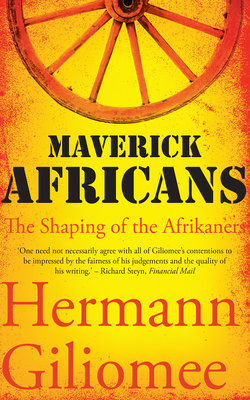Читать книгу Maverick Africans - Hermann Giliomee - Страница 4
На сайте Литреса книга снята с продажи.
PREFACE
ОглавлениеThis book is a companion volume to The Rise and Demise of the Afrikaners, published early in 2019 by Tafelberg. The collection of essays in that book focused on the apartheid era and the transition to a negotiated settlement. The first part of this volume deals with the long-term historical forces that shaped the Afrikaner people: the powerful position that Afrikaner women enjoyed in their marital relationships under Roman-Dutch law, the expanding frontier which gave rise to individualism and later to republicanism, the struggle of the Dutch Reformed Church to remain racially exclusive while spreading the gospel to black people, and the rise of the nationalist movement that carried the Afrikaners to power in 1948.
The second part of this book covers key aspects of the political history of the past quarter of a century, some of which are still controversial. Chapter 5 examines the real and alleged politicisation of the civil service subsequent to regime change in 1948. Rumours of improper political interference abound, but the fact is that until 1994 a stable and professional service supervised by the Public Service Commission was one of the country’s strengths. Although Afrikaners dominated the political system, it was only in the mid-1960s that the upper levels of the civil service reflected the division between Afrikaans- and English-speakers in the composition of the white population. Expertise was retained despite political divisions. Within thirteen years after 1994, however, the civil service reflected the county’s racial composition but at the cost of an enormous loss of experience and expertise.
As I argue in chapter 6, the struggle between African and Afrikaner nationalism was not, as the leadership of the ANC has portrayed it, between the ANC’s non-racialism and the National Party’s apartheid policy but between two different communities. The one, led by Afrikaners, stressed a form of self-determination over issues like education, culture, language, the market and property rights. On the other hand, while proclaiming itself to be a non-racial movement, the ANC was in fact a typical populist movement that wanted to gain full control of the state and the land.
Chapter 7 deals with corruption perpetrated by or condoned by the state. This has been a key issue from the start of ANC rule. In a counter-attack, some ANC leaders have charged that the NP government either initiated or condoned corruption on a substantial scale under its watch. The chapter examines the famous ‘lifeboat’ issue involving state aid to Bankorp during a serious financial crisis in the 1980s.
The subject of chapter 8 is Piet Cillié, long-time editor of Die Burger. He was regarded by several of his peers as the most formidable opponent of Prime Minister Hendrik Verwoerd in Afrikaner nationalist ranks. Surprisingly, his critical voice became quiet when John Vorster became leader. Chapter 9 discusses the leadership qualities of people at the helm of the apartheid state. Finally there is a chapter on the current fractured state of the Afrikaner community.
I wish to thank Annette for giving me the mental space to write, Erika for her unwavering support, Albert for exchanging ideas on history and university life, and my children and grandchildren who have not yet read any of my books but whose energy and lewenslus are a source of great pleasure. It is to them that I dedicate this book in the hope that they will one day read it.
HERMANN GILIOMEE
Stellenbosch, 21 November 2019
